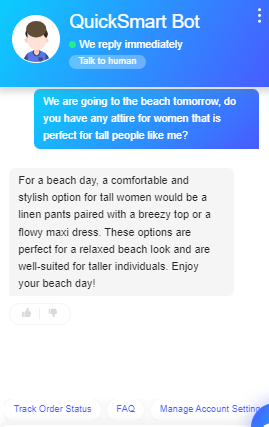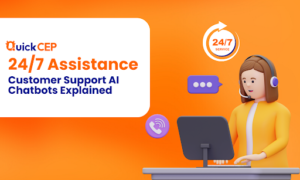With the increasing prominence of AI chatbots and assistants in customer service, many are asking “Will AI replace customer service?”
It’s no surprise this concern is on top of mind, especially for people working in customer service. Compared to human agents, AI chatbots can handle high-volume tickets simultaneously and provide instant 24/7 assistance at a lower cost.
AI is proven to meet the evolving customer demand for better support service. Around 84% see AI improving customer experience and 46% claim it enhances personalization.
Yet, many also argue that AI can never replace human agents. Many are still seeking that level of empathy and care (the “human touch”) when they approach a help desk.
How imminent is AI takeover in customer service? Will support reps remain relevant in the future?
Let’s discuss.
How has AI Changed Customer Service?
Decades ago, support reps manually handled customer concerns via calls or emails. Many tickets take hours to resolve because agents need to meticulously review product details, company guidelines, or transaction histories. So long lines (and frustrated customers) were very common back then.
Until AI entered the plot and changed everything.
AI chatbots can instantly answer customer queries 24/7 without human intervention. By “talking” to these chatbots, customers can obtain timely assistance for their concerns. This ultimately reduced long waiting lines at help desks, making customers happy and satisfied. Around 80% of customers who interacted with AI-driven support software had a positive experience.
AI Customer Service Solutions
Different AI customer service solutions benefit many firms worldwide such as:
1. Chatbots and Virtual Assistants
Chatbots and virtual assistants interact with customers in human-like conversations. Using artificial intelligence, they can provide tailored-fit responses to customers by understanding the intent and context of their inquiries. Around 87% of customers are satisfied with connecting with AI chatbots because of their promptness, reliability, and round-the-clock availability. Meanwhile, virtual assistants are useful not only in addressing customer queries. They can also provide product suggestions, offer discount vouchers, or guide customers in their purchase journey.2. Customer Journey Mapping
Companies can use AI to determine patterns and insights in customers’ purchasing behavior. For instance, AI can analyze hundreds of monthly support conversations and summarize pain points that must be addressed. AI-driven analytics can also unravel current customer behavior and trends, helping you create a data-driven sales and marketing decision.3. Analysis Using AI
Around 65% of customers are now anticipating a personalized experience when connecting with companies. So, it’s now imperative for firms to add personalization to their support service. AI analytics is one way to achieve this goal. AI-powered tools can extract insights from customer data like their purchase history, site visits, and previous support tickets. From here, you can target your customers’ preferences and needs, providing them with a personalized experience.4. Automating Business Processes
AI support tools can handle support workflows in automation like ticket generation, agent handover, order tracking, and feedback collection. They can also perform repetitive tasks with consistent performance and a lower chance of error. As AI automates some of your business processes, your staff can spend their time and energy on more pressing issues.Challenges And Concerns Related to AI Customer Service
Although AI beats humans in speed and efficiency, this technology is not flawless. Before integrating it into your business, it is crucial to recognize AI’s current limitations.
AI Hallucinations
“AI Hallucination” pertains to a situation in which the AI provides erroneous, misleading, or fictional information to the user. Suppose you ask an AI chatbot about the price of a new product. The AI responded but upon verification in the store’s website, the AI provided an incorrect price. This is an example of hallucination. According to SiliconAngle, around 3% to 10% of AI responses are “hallucinations”. Fortunately, there are risk-mitigating measures for this problem. For instance, fine-tuning models with accurate and clear training data can reduce hallucinations. Another approach is by “prompt engineering” or conditioning AI to produce the best responses by refining and optimizing inputs.Lack of “Human Touch”
Since AI is just a bunch of codes pieced together, it cannot engage in an “empathy-based” conversation. For instance, chatbots do not care if the customer is already furious, disappointed, or anxious, they will only respond and leave the customer alone.Privacy and Security
AI collects personal information when conversing with customers. So, it’s a challenge for firms to place robust data privacy and security measures to avoid misuse, leaks, or breaches.Limited Accountability
Who is to blame if AI provides misleading or harmful information to customers? Is it the customer service head? the CEO? or the IT professional? Adopting AI poses a challenge in upholding accountability in the firm. So, it’s essential to modify the company guidelines for clear determination of accountability for any issues.Looking Ahead: How Can You Use AI for A Better Customer Experience?
Upon knowing the limitations of AI solutions in customer service, you must consider these factors to effectively build one for your business.
Personalized Recommendations
Build an AI that provides personalized product suggestions to customers according to their needs and interests. For instance, QuickCEP’s AI chatbot can give relevant product recommendations according to customer’s preferences.

Multilingual Capability
If you have global clients, training an AI in multiple languages can help you provide inclusive customer service. This will enable your customers around the globe to obtain support at any time.
Agent Handoff:
Some inquiries might be too complex for the AI to answer. Thus, it’s essential to add a seamless agent handover feature in your chatbot or virtual assistant. A simple button indicating “Talk To Human” can do this job.
Analytics
Use AI software that has data analytics capability that determines your current support performance and customer sentiment. Your AI chatbot (or virtual assistant) must come with performance metrics or an analytics dashboard to help you improve your service.
So, Will AI Replace Customer Service?

“AI takeover” is still largely impossible, at least in the near future. While many customers appreciate AI’s efficiency and reliability, many are still seeking that “emotional connection” that only human agents can provide.
Yet, it’s certain that AI will stand as the chief technology in customer service. Support teams must leverage AI in their processes to thrive in today’s cutthroat market with rapidly changing customer expectations.
Will you join the AI revolution or let competitors outlast you? Explore a FREE AI chatbot solution today and see the difference.



